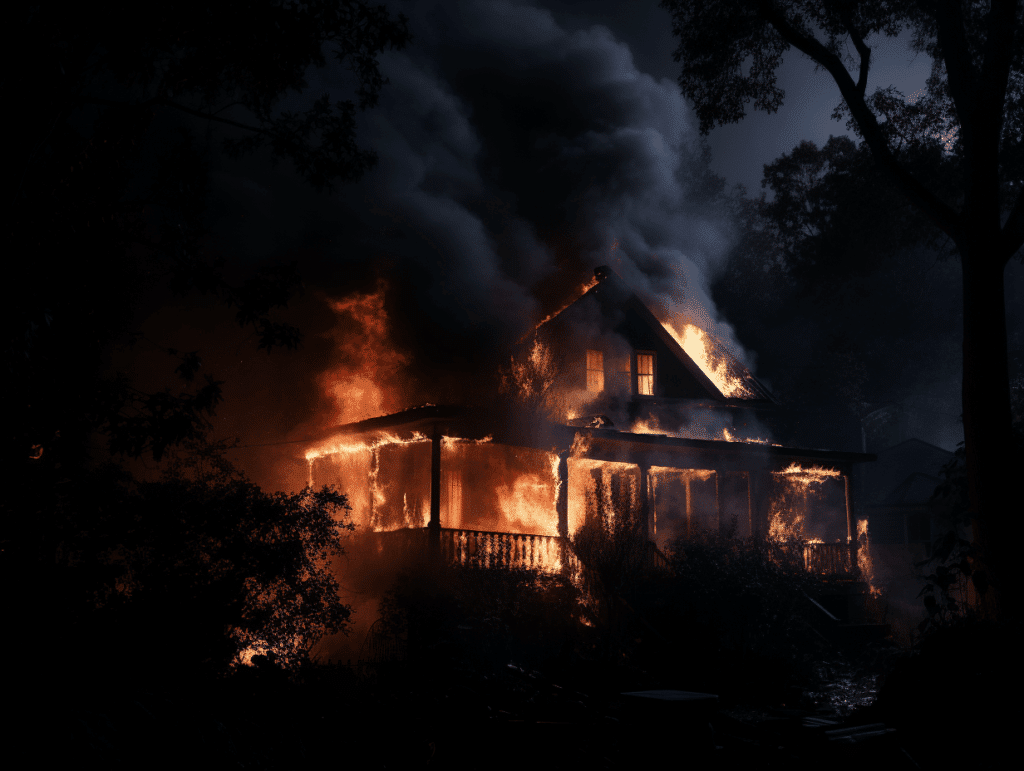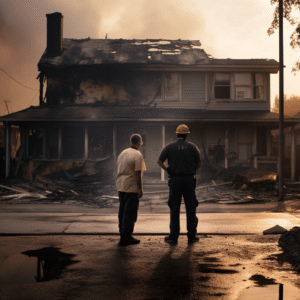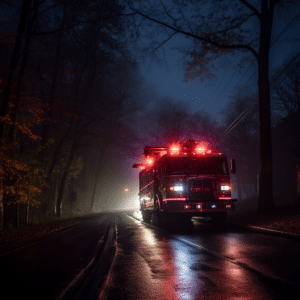Let's Go Beyond, to Bring You Back
Let's get you the compensation you're entitled to. Get a FREE Consultation today.
Let's Go Beyond, to Bring You Back
You deserve the compensation you’re entitled to, call for your FREE Case Review today.
The Fire Damage Restoration Process Explained
Fire damage restoration follows a methodical fire restoration process to return a property to its original state following a fire. This process includes:
- Damage evaluation
- Property protection
- Water removal
- Debris clearance
- Sanitation
- Reconstruction
The role of an experienced professional is crucial in this process as they can identify hidden problems, understand the complexities, and evaluate the damage accurately. Initiating the restoration process without delay ensures the salvage and functionality of your property.
Immediately after extinguishing the fire, reaching out to a fire damage restoration company is of paramount importance. This allows them to evaluate the damage, give an estimate, and initiate the fire damage restoration service, thereby reducing the damage to the property. Following the National Fire Protection Association guidelines guarantees a safe and efficient restoration process, which is often supported by the fire department.
Initial Assessment and Safety Measures
The initial assessment is a critical step in the fire damage restoration process. Its purpose is to accurately assess the extent of the damage, identify any safety concerns, and formulate an effective restoration plan. This assessment involves evaluating the severity of the damage, assessing safety issues, and creating a comprehensive restoration plan. The damage assessment helps to identify the extent of work, the timeline for completion, and calculate an estimated cost.
During the damage assessment, avoid turning on lights or cleaning electrical appliances as compromised wiring could potentially spark another fire. The restoration plan details the necessary tasks for the fire damage restoration job, the expected timeline for the restoration services, and the cost estimate.
Securing and Protecting the Property
During the fire damage restoration process, property security is key to avoid additional complications. Methods to secure a fire-damaged property effectively include boarding up windows and doors, installing smoke detectors, and damage evaluation. It is important to seal off undamaged areas to prevent cross-contamination, thus restricting the spread of smoke, soot, and other contaminants from damaged to unaffected areas. This maintains cleanliness while reducing the risk of additional damage or health hazards.
The significance of sealing off undamaged areas of the property lies in preventing cross-contamination and ensuring the safety of the remaining undamaged spaces. By taking these measures, the property owner can mitigate the risk of further damage and create a safe environment for the restoration process to take place.
Water Extraction and Drying
Water extraction and drying are key steps in the fire damage restoration process to prevent mold growth and further property damage. Dehumidifiers and air movers are utilized to dry out the water during the restoration process. Upon water extraction, drying and dehumidifying services are carried out to prevent further damage.
The purpose of the Demolition, Water Removal & Dry Out stage is to avert additional damage caused by mold or corrosion by eliminating water and drying out the premises. Efficient water extraction and drying not only prevent further damage to the property but also ensure a safe and clean environment for the occupants.
Texas Bad Faith Insurance Lawyer
Get Compensated For Your Injuries & Damages! Call Us For A FREE Case Review And Know What Your Case Is Worth.
Debris Removal and Demolition
Removing debris and demolition form crucial parts of the fire damage restoration process. These steps aim to:
- Remove damaged items
- Carry out controlled demolition of irreparable structures
- Take out personal possessions from the building’s interior
- Remove damaged drywall, flooring, and other materials as necessary
The process of debris removal after a fire incident typically involves assessing the damage, removing hazardous materials, clearing the debris, disposing of the debris, and documenting the cleanup. Excavators, track-type tractors, wheel loaders, personal protective equipment (PPE), inspection and assessment tools, and air quality and filtration equipment are some of the tools and equipment utilized in fire damage debris removal.
Clearing Debris and Damaged Items
In fire restoration, damaged items are identified and separated from salvageable ones by carefully examining and assessing the condition of each item. Restoration experts may use photo documentation, identification numbers, and detailed records to keep track of the items, determining if the soot, smoke, and odor can be removed from the items. Items that are severely damaged or cannot be restored will be separated and considered non-salvageable.
Debris removal following a fire requires the use of the following equipment and protective gear:
- Boots
- Jumpsuits
- Litter picker claws
- Heavy-duty gloves
- Trash bags
- Hazmat suits
- Masks
- Shakers
- Tub grinders
- Wood chippers
- Air-curtain equipment
It is critical to manage and discard hazardous materials correctly to reduce health risks.
Controlled Demolition
Controlled demolition in fire damage restoration is the process of demolishing and removing irreparable structures to prepare the site for reconstruction. The procedure typically includes:
- Evaluation of the damage
- Securing the area
- Eliminating damaged components
- Cleaning and deodorizing
- Testing and repairing
- Carrying out a safety inspection
During a controlled demolition in fire damage restoration, the following tools and equipment are generally utilized:
- Dozers
- Excavators
- Personal protective equipment (PPE)
- Vacuums
- Tools for scraping, sanding, and sealing charred or damaged surfaces
This process ensures a safe and clean environment for the reconstruction phase.
Cleaning and Decontamination
Cleaning and decontamination hold great importance in fire damage restoration as soot can corrode building materials and hazardous fire byproducts need professional and safe cleaning and removal. The restoration team will evaluate the smoke damage, carry out structural cleaning, and control odors. Before painting any walls, ceiling, or trim unaffected by the fire, they will clean and sand them for priming and painting.
Exposure to soot and smoke in the aftermath of a fire may lead to respiratory ailments such as asthma and bronchitis, as well as an increased risk of cancer and heart disease. Therefore, it is essential to take proactive measures to mitigate any potential health hazards that may be caused by the soot and smoke damage, including thorough cleaning and decontamination.
Soot and Smoke Damage Removal
The process of soot removal involves cleaning surfaces, removing odors, and addressing any potential health hazards. A dry-cleaning sponge or dry chemical sponge can be employed to efficiently remove soot residue from surfaces. Using paint thinner or rubbing alcohol is recommended for removing soot residue from walls. It is essential to wear gloves and take necessary precautions while cleaning after fire damage.
To mitigate potential health hazards, it is important to ensure proper cleaning and disposal of hazardous materials. This includes using a combination of mild soap, tri-sodium phosphate (TSP), and chlorine bleach in warm water for cleaning surfaces and appropriate disposal of hazardous materials.
Sanitizing and Deodorizing
Sanitizing and deodorizing the property after fire damage are essential steps in ensuring a safe and healthy environment. The most effective methods for sanitizing and deodorizing a property after fire damage include:
- Professional steam cleaning
- Using a heavy-duty vacuum cleaner with a HEPA filter
- Cleaning surfaces with warm water and soap
- Using a dry-cleaning sponge
- Thermal fogging
It is imperative to wear gloves and take necessary precautions while cleaning after fire damage.
By employing these methods, you can effectively sanitize and deodorize your property, preventing mold growth and ensuring a safe and clean environment for all occupants. This is an important step in the overall fire damage restoration process.
Reconstruction and Repairs
The final steps in restoring a property after fire damage involve reconstruction and repairs. These processes include:
- Restoring the property’s structure
- Restoring the electrical, plumbing, and HVAC systems
- Rebuilding the roof, electrical wiring, drywall, flooring, counters, and fixtures
- Carrying out necessary repairs due to fire damage or reconstructing areas damaged by fire
These steps are essential in restoring the property to its original state.
By completing these steps, you can ensure that your property is fully restored and ready for occupancy. With the right fire damage restoration company and proper planning, you can make the entire process as smooth and efficient as possible.
Structural Repairs
Structural repairs are an important aspect of the fire damage restoration process. They include rebuilding damaged areas such as walls, ceilings, and flooring. Typical materials employed in the reconstruction of walls, ceilings, and flooring following fire damage include drywall, plaster, tiles, carpeting, and flooring materials such as hardwood or laminate.
The structural repair process following a fire may range from a few days to multiple months, depending on the severity of the damage. By conducting thorough damage assessment and using appropriate materials, you can ensure that your property is restored to its original condition.
Electrical, Plumbing, and HVAC Systems
Repairing electrical, plumbing, and HVAC systems is essential for ensuring a functional and safe property after a fire. Electrical damages caused by fire include defective electrical outlets, aged appliances, overloaded circuits, electrical wiring damage, and electrical system malfunctions. The procedure for repairing electrical systems after fire damage typically entails assessing the damage, securing the area, eliminating damaged components, cleaning and deodorizing, testing and repairing, and carrying out a safety inspection.
A house fire can have a significant effect on plumbing systems, causing pipes to expand and burst, leading to water leaks and flooding. Smoke and soot can enter the plumbing system, resulting in blockages and damage to fixtures and pipes. It is essential to have a professional plumber assess and repair any damage to the plumbing system after a fire.
By addressing these critical systems, you can ensure a safe and comfortable environment in your restored property.
Choosing the Right Fire Damage Restoration Company
Choosing the right fire damage restoration company is a key factor in a successful restoration process. Considerations should include:
- The company’s expertise
- Certifications
- Customer service
- Communication skills
Certifications verify the company’s competence and ability to handle the restoration process, while expertise in fire damage management guarantees proper cleaning and disposal of hazardous materials, minimizing further damage and ensuring effective restoration.
A company with excellent customer service and communication can provide guidance throughout the complex restoration process, answer common questions about fire claims, and ensure a smooth and efficient experience for the client. By choosing a reputable fire damage restoration company with a proven track record of successful projects, you can ensure that your property is restored to its pre-fire condition.
Expertise and Certifications
Expertise and certifications in fire damage restoration are crucial factors when selecting a company for the restoration process. Certifications guarantee that the professionals involved possess the requisite knowledge and abilities to accurately assess, control, clean, and restore fire-damaged properties. By attaining certifications, professionals demonstrate their proficiency and dedication to upholding industry standards, ultimately resulting in more efficient and successful fire damage restoration projects.
Some of the available fire damage restoration certifications include:
- Fire and Smoke Restoration Technician (FSRT) certification
- Applied Microbial Remediation Technician (AMRT) certification
- Applied Structural Drying Technician (ASD) certification
By choosing a company with the appropriate expertise and certifications, you can ensure that your property is restored to the highest standards.
Customer Service and Communication
Customer service and communication are essential for a smooth and efficient restoration experience. A fire damage restoration company with excellent customer service can guide you through the complex process, answering common questions about fire claims, and providing regular updates even if not asked for. Ongoing communication assists in keeping clients informed and reassured during the restoration process, thus reducing anxiety and providing reassurance.
Consistent and effective communication builds trust between the client and the service provider, which is essential for a positive client experience and can lead to long-term relationships and referrals. By selecting a company with strong customer service and communication skills, you can ensure a smooth and successful fire damage restoration process.
Texas Bad Faith Insurance Lawyer
Get Compensated For Your Injuries & Damages! Call Us For A FREE Case Review And Know What Your Case Is Worth.
Insurance Claims and Financial Considerations
Insurance claims and financial considerations are significant aspects of the fire damage restoration process. Collaborating with your insurance company ensures accurate documentation and coverage for the restoration process, while cost estimation and budgeting help you plan for the financial aspects of the restoration and avoid unforeseen expenses.
The process of filing an insurance claim for fire damage typically involves the following steps:
- Secure your property against further damage.
- File your insurance claim immediately.
- Document losses by taking photographs and making a list of everything that was damaged or destroyed.
- Request an advance on the claim if necessary. By working closely with your insurance company and fire damage restoration professionals, you can ensure that your property is restored and your financial interests are protected.
Working with Your Insurance Company
Working with your insurance company during the fire damage restoration process is of utmost importance. They provide guidance throughout the claims process, evaluate the damage, and may suggest specific restoration companies for assistance. They are responsible for restoring your home and contents to their pre-loss conditions or providing compensation.
Having a fire damage restoration company that can assist with insurance claims provides assurance and reduces the stress associated with the situation. By maintaining open and transparent communication with your insurance company, you can ensure that your claim is properly documented and covered. Working with a reliable fire damage contractor can make the process of fire damage restoration smoother and more efficient.
Estimating Costs and Budgeting
Estimating costs and budgeting are essential aspects of the fire damage restoration process. The average cost of fire damage restoration ranges from $3,000 to $40,000, with an average price of $11,900. Additional costs may include:
- Soot damage repair
- Odor removal
- Structural repairs
- Hidden damage
- Temporary housing
Homeowners should expect to pay between $3,500 and $5,000 for small fire damage restoration, with a cost per square foot of approximately $4.70, while soot damage restoration can range from $400 to $1,700. It is essential to assess the specific damage and consult with professionals to obtain an accurate estimate for budgeting purposes.
Frequently Asked Questions
How do you restore after a fire?
After a fire, it is important to assess the damage, secure the property, remove debris, demolish, dry out, clean up, remove smoke, and restore or reconstruct the area.
How long does it take to rebuild after a fire?
Rebuilding after a fire can take anywhere from a few weeks to a year depending on the extent of damage, but we understand that you want to get back into your home and start rebuilding your life.
What are the steps for cleaning up after a fire?
Cleanup after a fire involves using mild soap or detergent, mixed with Tri-sodium phosphate and household cleaner or chlorine bleach in warm water, to remove soot and smoke from walls, furniture and floors. Be sure to rinse surfaces with clear warm water and dry thoroughly. Wear rubber gloves for protection.
What is the first step in the fire damage restoration process?
The first step in fire damage restoration is to evaluate the damage and contact restoration services promptly.
How long does the fire damage restoration process take?
The fire damage restoration process can take anywhere from a few days to multiple months, depending on the extent of the damage and the size of the property.




